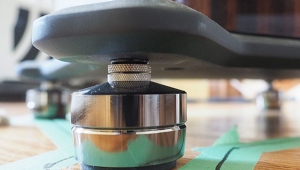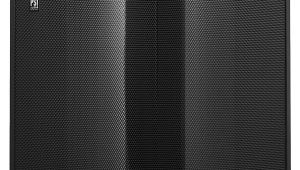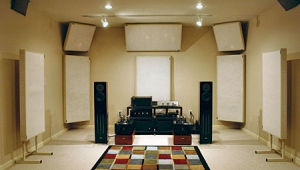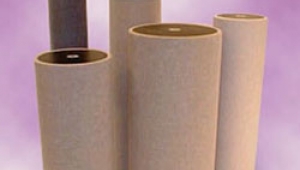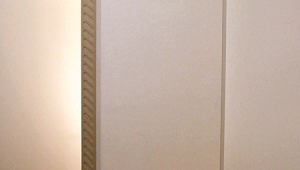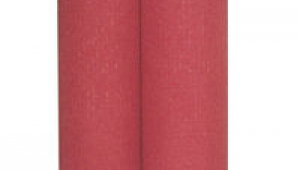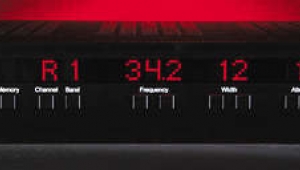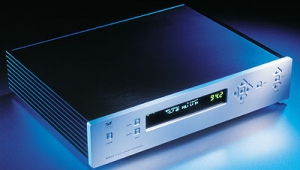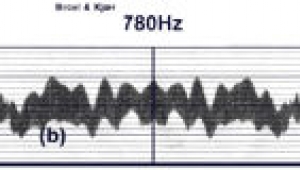| Columns Retired Columns & Blogs |
Echo Busters Decorative Room Treatments Page 2
The verdict: Another winner. The Echo Buster is light and easy to use, even to hang on a ceiling. And the benefits, while sometimes subtle, are always audible and worth the work. At prices ranging from $130 for the smallest model to $285 for the largest, it's definitely worth having a few Echo Busters around.
Double Buster
The Double Buster is a panel diffuser similar in size and appearance to the Echo Buster absorber. But instead of an absorptive foam core, the Double's wooden frame is filled with a rigid panel of corrugated material. The idea is that they reflect high frequencies from a constantly changing plane, jumbling up the coherence of the reflected waveforms.
I'm a big fan of diffusers, particularly behind and around speakers and on the wall behind the listening chair. I've experimented with absorbers in these locations, but have always found that they collapse the image: Clarity, precision, and detail are excellent, but the soundstage is shrunken, without the sense of air and breath around the music.
The setups I used back in Albuquerque varied widely, depending on the speaker I was auditioning. Typically, I would cover the windows behind the speakers and the wall behind my chair, using two Double Busters in each spot. For a lot of speakers, I would end up locating a pair of Double Busters behind each speaker, the DBs often leaned against each other to form a wedge behind the speakers. I also often used DBs outboard of the speakers, where they could reflect sound back into the general area between and behind the speakers, to widen and open up the soundstage.
The Double Busters' effects were typically subtle, but well worth the time I spent with them to optimize my system, as well as their price of $180/each for the smallest model. The big benefits were in soundstaging—expanding and opening up the stage, increasing the spaces between performers, and creating around them a coherent, live-feeling space.
Another verdict: Another winner.
Back to the Future
Finally moved into our gorgeous house in the California hills, I was delighted to discover that my new and, er, unusual listening space had no major bass problems. The large, open area isn't shaped or sized to reinforce any particular frequency region, but in mapping the room with my trusty RadioShack meter, I discovered that I had slight boosts in the upper bass/lower midrange in the room's corners, and between and behind the speakers.
To beat the boosts, I began with a single Bass Buster in each corner, and a one-high half-round column between and behind the speakers. With the two speakers I've used thus far, the Audio Physic Virgo III and the Thiel CS6, the BBs seemed to clean up the bottom end a bit, although I noticed this effect more in the lower than the higher frequencies. One example: The row of double basses at the opening of Saturn, from Zubin Mehta and the L.A. Philharmonic's reading of Holst's The Planets (LP, Decca/London CS 6734), seemed clearer with the Bass Busters in place. With the BBs, it was easier to distinguish the individual basses and to discern their positions in the row.
Upper-bass information, such as a lot of Ray Brown's work on Soular Energy, sounded wonderful with the Bass Busters in place, but not hugely different than without them. It's worth noting, however, that both the Virgos and the big Thiels don't pressurize my space the way they would a smaller room; I probably need BBs less than just about anyone else. Even so, the slight improvements in bottom-end clarity and precision were worth the effort.
Sonically, one of my new room's most horrifying features is the huge, smooth, marble-and-glass fireplace that forms the wall between and behind the speakers. Untreated, that wall functions as a huge reflector, centering high-frequency information to the point where treble instruments seem to emanate from only three sources: the two speakers and the fireplace. The image is all jumbled into a confused mass between the speakers, and individual instruments aren't coherent at all. Different parts of the frequency spectrum seem to come from different places, and vary widely in amplitude and dynamics.
I threw the entire Echo Busters toolkit at the fireplace wall, experimenting with a range of setups varying from a wall of Bass Busters, round sides out, to a wall of Double Buster diffusors. All combinations were better than nothing, but none was perfect. Even though my answer is usually "add more diffusers," that didn't turn out to be the best approach. It solved the original problems, and I ended up with a huge, continuous soundstage, but it was a little too huge. The spaces between performers sounded a bit stretched-out, and the surrounding walls of the recording venues were way out there—too far to be consistent with the ambience cues. Images were a bit too large as well, and not nearly as dense and sharply focused as they should be.
After several long sessions of experimentation, I arrived at the optimal setup—at least for the speakers I'd used thus far. In addition to the half-column of Bass Busters I mentioned earlier, I ended up covering about 75% of the fireplace wall with a mix of two-thirds Double Buster diffusers and a third of Echo Buster absorbers. I also added a floorstanding DB outside and slightly forward of each speaker, angled to reflect sound back to an area between and behind the speakers.
Ahhh...nirvana. The reflector-from-hell fireplace was completely gone, in its place a soundstage that was huge but coherent, and well-proportioned. Images were realistically sized, tangible, and dense. A nice mix of detail and specificity was complemented by coherence and seamlessness. The final touch—those two outboard Double Busters—extended the rear corners of the soundstage rearward and out, transforming it from a trapezoid deeper in the center than on the sides into more of a rectangle.
Last but not least, I stood a pair of Double Busters on the wall behind my listening chair, which seemed to deepen the soundstage a bit more, and added diffusers to the first reflection point on the left wall, which is made of glass. There was a slight improvement in detail and focus, but because my speakers are well in from the wall, the effect was pretty subtle.
Summing Up
I'm a big fan of Echo Busters' products. I think every serious audiophile should at least try them. Whether you're wrestling with problems as big as my Albuquerque bass boost or my California fireplace, or fine-tuning image focus and soundstage air, the Busters are great tools to have at your disposal. As a reviewer who is constantly changing setups and equipment, I can't imagine doing my job without these products. And as a music-lover, now that I've heard what Echo Busters can do for a system, I never want to be without them. They get my highest recommendation.
- Log in or register to post comments
